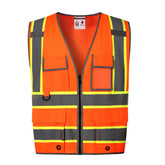Who Is Responsible for Training Workers on the Use of PPE?
In every job site—from construction zones to warehouses to roadside maintenance—personal protective equipment (PPE) plays a vital role in keeping workers safe. But simply providing PPE is not enough. Workers must know how to use it correctly, when to wear it, and how to maintain it.
So, who is responsible for making sure that training happens? The short answer: the employer. Let’s break down what OSHA says about PPE training responsibilities and what workers should also know to stay compliant and safe.
Employer Responsibilities Under OSHA
According to the Occupational Safety and Health Administration (OSHA), employers are legally responsible for both providing and training employees on the proper use of PPE.
Under OSHA Standard 29 CFR 1910.132(f) and the official publication OSHA 3151 – Personal Protective Equipment employers must:
-
Assess the workplace to determine potential hazards.
-
Select the appropriate PPE for each type of risk.
-
Provide PPE at no cost to employees.
-
Train workers on how to properly wear, use, maintain, and replace PPE.
-
Maintain written certification of each employee’s completed training.
The training must cover:
-
When PPE is necessary
-
What type of PPE is required for the job
-
How to properly put on, adjust, wear, and remove PPE
-
How to care for and maintain PPE
-
How to recognize signs of damage or failure
For example, when it comes to hi-vis safety apparel, workers must learn how to maintain reflective materials, keep garments clean, and ensure high visibility under different lighting conditions.
Worker Responsibilities
Although OSHA makes it clear that employers are responsible for PPE training, employees also have an essential role.
Workers are expected to actively participate in training, follow all safety procedures, and report any PPE issues or damage.
As stated in OSHA 3151, employees must “understand the training and use the equipment properly.”
Here are a few quick tips for workers:
-
Keep your hi-vis gear clean and free from dirt that can cover reflective strips.
-
Inspect your PPE daily for tears, fading, or wear.
-
Replace damaged or ineffective PPE immediately.
-
Always wear PPE in required zones, even if it feels inconvenient.
Common Mistakes and Best Practices
Common mistakes:
-
Thinking PPE distribution alone meets OSHA requirements.
-
Training workers only once, without regular refreshers.
-
Failing to match PPE types with specific job hazards.
Best practices:
-
Employers should update PPE training whenever tasks, tools, or job conditions change.
-
Include PPE instruction in all new-hire orientation programs.
-
Keep detailed records of training completion for accountability.
-
Workers should take ownership of their own safety by applying what they’ve learned daily.
In the United States, employers bear the primary responsibility for PPE training under OSHA law. However, workers share the duty of using and maintaining PPE correctly.
Proper PPE training not only keeps you safe but also ensures legal compliance and builds a culture of safety at every job site.
Protect yourself and stay compliant — choose high-visibility PPE that works as hard as you do.
Explore HivisPro’s hi-vis safety apparel collection for durable, OSHA-compliant protection built for real workers.





